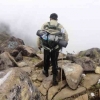After the story shifted from the jungle to the human village, fire as a weapon no longer appeared in the story. The fire became a useful part of daily village life. This is seen from the narration "the crowd beckoned Mowgli to her hut, where there was a red lacquered bedstead, a great earthen grain chest with funny raised on it, half a dozen copper cooking POTS, an image of a Hindu god in a little alcove, and on the wall a real looking glass, such as they sell at the country market" A large crate of grain with a funny lifting pattern on it, a half a dozen copper cooking POTS, a picture of the Hindu god in a small niche, and on the wall a glass appeared to be real, like the one they had sold in a rural exhibition] (Kipling, 1894). At this point, the mention of a copper cooking pot packed together with other living utensils indicates that fire for the villagers was part of daily life, and particularly as a cooking instrument, so fire became a useful tool for survival without the use of it as a weapon.
At the story resolution, fire involvement in its many shapes is virtually invisible. Tensions built at the height of the confrontation between mowgli and shere khan did not even mention the involvement of fire. At the end of the confrontation between mowgli and shere khan, shere khan's state was described as a drunk, drunk tiger, "he killed dawn, - a pig, - and he had drunk too" [he had consumed at dawn, - a pig, - and he was drunk too] (Kipling, 1894). Meanwhile, mowgli himself could not use any fire at all, at the waiting time of shere khan's ambush, looking forward to having his brother grey brothers watch and watch. While at the height of his battle with shere khan, mowgli used a herd of buffalo to trample shere khan to death.
- Discussion of Appeal to A Particular Audience
The very existence of fire as something that gives quite a dangerous impression, it only appears in depictions that provide an atmosphere that displays a brave impression. Or, if it could be argued as dangerous, it would not be in the physical sense. At one point the expression "he has eyes like red fire" [he has eyes like red fire] (Kipling, 1894) or as it appears on the part following the confrontation "when the moon rose over the plain, making it look all milky, the making it look at his heels Mowgli, with two wolves at his heels and a bundle on his head, trotting across at the steady Wolf's trot that the Terrified villagers saw Mowgli, with two wolves at his feet and a band of bunches on his head, running across with steady Wolf steps that devoured the long road like fire] (Kipling, 1894).
Baca konten-konten menarik Kompasiana langsung dari smartphone kamu. Follow channel WhatsApp Kompasiana sekarang di sini: https://whatsapp.com/channel/0029VaYjYaL4Spk7WflFYJ2H







